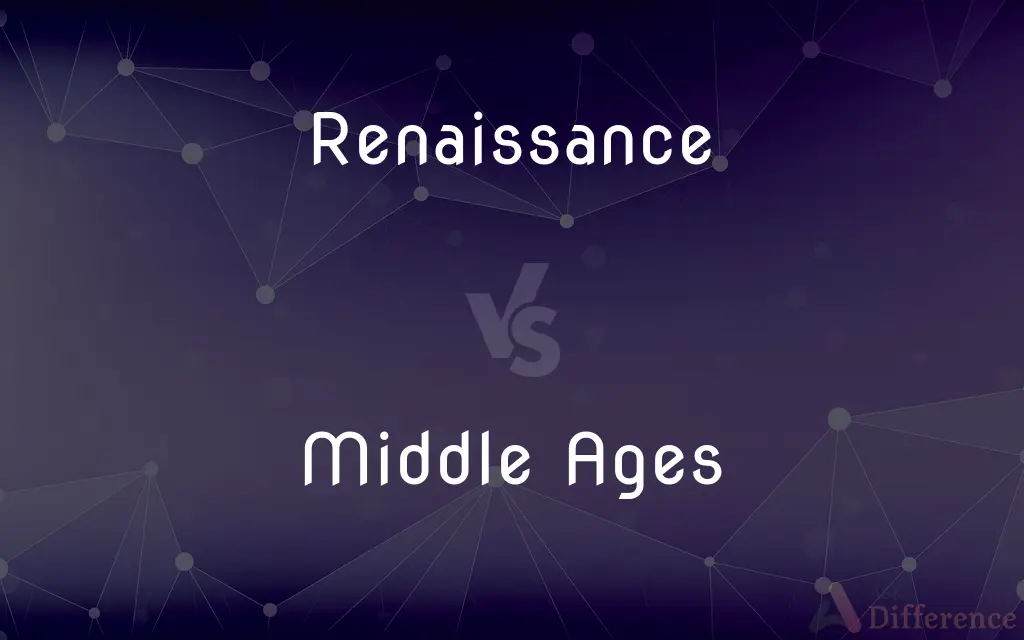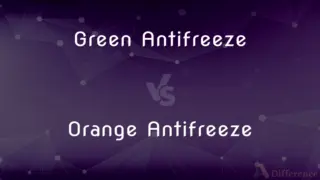Renaissance vs. Middle Ages — What's the Difference?
Edited by Tayyaba Rehman — By Maham Liaqat — Published on March 5, 2024
The Renaissance was a period of rebirth in arts and sciences, moving away from the Middle Ages' focus on religion and feudalism to humanism and exploration.

Difference Between Renaissance and Middle Ages
Table of Contents
ADVERTISEMENT
Key Differences
The Renaissance, beginning in the 14th century in Italy, marked a significant shift towards humanism and the revival of classical learning and wisdom. In contrast, the Middle Ages, spanning from the 5th to the late 15th century, were characterized by feudalism, the dominance of the Church, and a relatively static social order.
Art during the Renaissance focused on realism, perspective, and human emotion, showcasing human beauty and the natural world. Middle Ages art was predominantly religious, aiming to teach moral lessons and stories from the Bible through stylized and symbolic representations.
Scientific advancements in the Renaissance were propelled by a renewed interest in Greek and Roman texts, leading to breakthroughs in various fields. The Middle Ages were marked by a reliance on religious explanations for natural phenomena, with limited scientific progress.
The Renaissance saw the invention of the printing press, significantly affecting the spread of knowledge. During the Middle Ages, books were painstakingly copied by hand, usually by monks, making them rare and expensive.
Politically, the Renaissance was a time of burgeoning nation-states and a decline in the power of the feudal system and the Church. The Middle Ages were characterized by a fragmented Europe with a strong influence of the Catholic Church over monarchs and daily life.
ADVERTISEMENT
Comparison Chart
Time Period
14th to 17th century
5th to late 15th century
Focus
Humanism, art, science
Religion, feudalism
Art
Realism, perspective
Religious, symbolic
Scientific Advancements
Greek/Roman influence, exploration
Limited, religious explanations
Political System
Rise of nation-states, decline of feudalism
Feudalism, strong Church influence
Compare with Definitions
Renaissance
A cultural movement emphasizing revival of classical learning and art.
Leonardo da Vinci's works epitomize Renaissance art.
Middle Ages
Characterized by the Crusades, military campaigns sanctioned by the Church.
The Crusades were a series of religious wars during the Middle Ages.
Renaissance
An era of humanism, focusing on human potential and achievements.
Renaissance literature often featured themes of individualism.
Middle Ages
Known for its distinctive art style focusing on religious themes.
Illuminated manuscripts are iconic artworks from the Middle Ages.
Renaissance
A period marked by significant advancements in science and exploration.
Copernicus proposed the heliocentric model during the Renaissance.
Middle Ages
A period dominated by feudalism and the manorial system.
Serfs worked the land for their lords throughout the Middle Ages.
Renaissance
A time of architectural innovation, including the use of perspective.
The dome of Florence Cathedral is a marvel of Renaissance engineering.
Middle Ages
An era with limited scientific progress due to religious constraints.
Galileo faced opposition from the Church, a mindset rooted in the Middle Ages.
Renaissance
The birthplace of modern printing technology.
Gutenberg's printing press revolutionized information dissemination in the Renaissance.
Middle Ages
Marked by the significant influence of the Catholic Church on society.
Gothic cathedrals symbolize the Church's power in the Middle Ages.
Renaissance
A rebirth or revival.
Renaissance
The humanistic revival of classical art, architecture, literature, and learning that originated in Italy in the 14th century and later spread throughout Europe.
Renaissance
The period of this revival, roughly the 14th through the 16th century, marking the transition from medieval to modern times.
Renaissance
A revival of intellectual or artistic achievement and vigor:the Celtic Renaissance.
Renaissance
A rebirth or revival.
Renaissance
The period of European history at the close of the Middle Ages and the rise of the modern world; a cultural rebirth from the 14th through the middle of the 17th centuries
Renaissance
The revival of learning and culture
Common Curiosities
What was art like during the Renaissance compared to the Middle Ages?
Renaissance art focused on realism and human emotion, while Middle Ages art was more religious and symbolic.
When did the Renaissance occur?
The Renaissance occurred from the 14th to the 17th century.
What political changes occurred during the Renaissance?
The Renaissance saw the rise of nation-states and a decline in the power of feudalism and the Church.
How did the printing press impact the Renaissance?
It revolutionized the spread of knowledge, making books cheaper and more accessible.
What role did the Church play in the Middle Ages?
The Church was a dominant force, influencing every aspect of life from politics to education.
How did the Renaissance influence modern science?
It laid the groundwork for modern scientific inquiry, with figures like Copernicus and Galileo challenging traditional beliefs.
How did scientific progress differ between the two periods?
The Renaissance saw significant scientific advancements due to interest in classical texts, unlike the Middle Ages, where progress was limited.
How did humanism influence the Renaissance?
Humanism shifted focus to human potential and achievements, influencing art, science, and literature.
What is the main difference between the Renaissance and the Middle Ages?
The Renaissance focused on humanism and the revival of classical learning, while the Middle Ages were centered around religion and feudalism.
Did the Renaissance affect all of Europe equally?
Its impact was felt differently across Europe, with Italy being the epicenter and other regions experiencing the Renaissance later.
What were the Crusades, and how do they relate to the Middle Ages?
The Crusades were military campaigns sanctioned by the Church, reflecting the Middle Ages' intertwining of religion and warfare.
Why is the Renaissance considered a period of rebirth?
It is seen as a rebirth due to the revival of classical art, science, and the shift from medieval to modern thinking.
Were the Middle Ages truly a "dark" period?
While often portrayed as dark due to limited progress, the Middle Ages also saw important developments, especially in architecture and the spread of Christianity.
What architectural differences distinguish the Renaissance from the Middle Ages?
Renaissance architecture featured symmetry, proportion, and the use of perspective, unlike the Gothic style prevalent in the Middle Ages.
What was feudalism, and how was it a hallmark of the Middle Ages?
Feudalism was a social system where land was held in exchange for service or labor, defining the Middle Ages' social and economic structures.
Share Your Discovery

Previous Comparison
Green Antifreeze vs. Orange Antifreeze
Next Comparison
Pak Choi vs. Bok ChoyAuthor Spotlight
Written by
Maham LiaqatEdited by
Tayyaba RehmanTayyaba Rehman is a distinguished writer, currently serving as a primary contributor to askdifference.com. As a researcher in semantics and etymology, Tayyaba's passion for the complexity of languages and their distinctions has found a perfect home on the platform. Tayyaba delves into the intricacies of language, distinguishing between commonly confused words and phrases, thereby providing clarity for readers worldwide.
















































